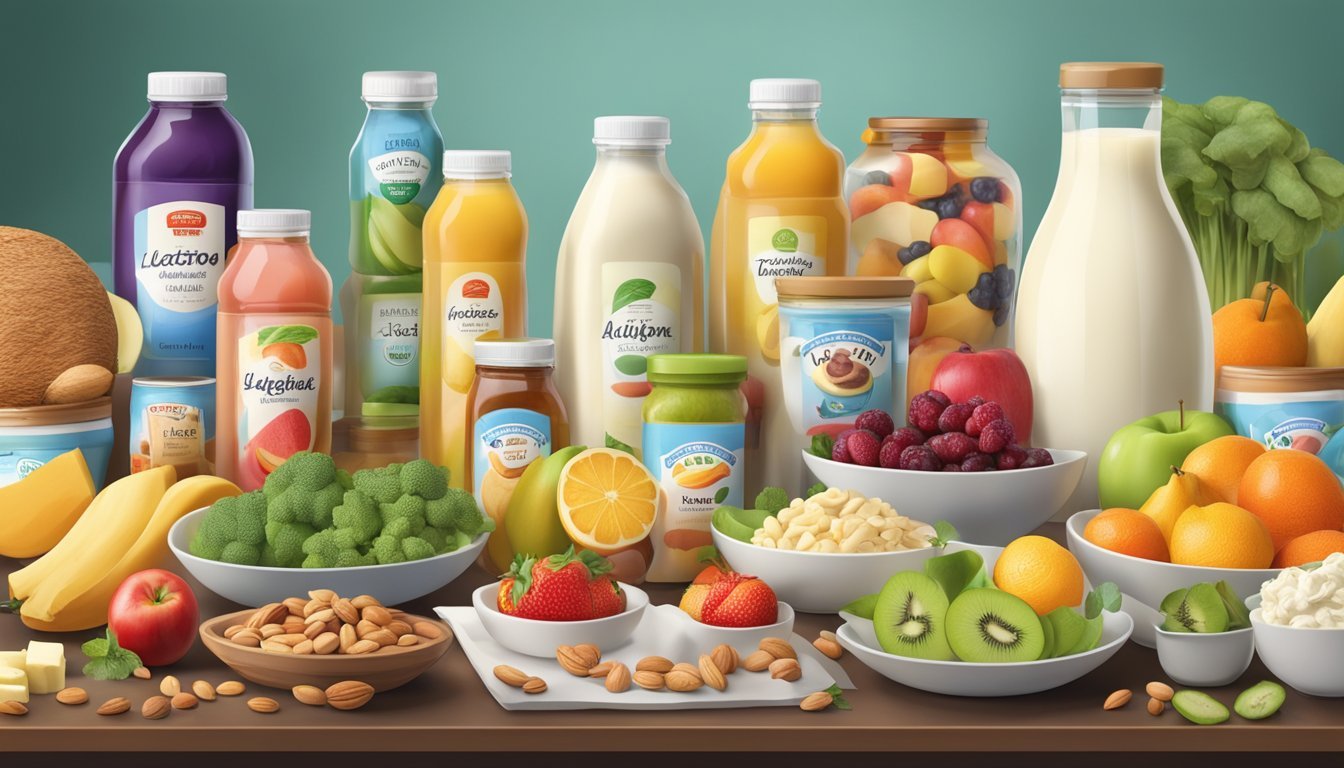Best Foods for Lactose Intolerance
Top Digestive-Friendly Choices
Lactose intolerance affects individuals by hindering their ability to digest lactose, the sugar found in milk and dairy products, due to a deficiency in the enzyme lactase. The onset of this condition can occur at any age and is often characterized by symptoms that include bloating, gas, cramps, nausea, and diarrhea. These symptoms typically emerge between 30 minutes and 2 hours after consuming lactose-containing foods. As a result, those who are lactose intolerant must be mindful of their diet to manage discomfort and maintain overall health.
The management of lactose intolerance primarily involves modifying one's diet to either limit or avoid lactose. Options include lactose-free alternatives and dairy products with reduced lactose content, which allow individuals to enjoy the taste and nutritional benefits of dairy without the adverse effects. Furthermore, a variety of non-dairy foods such as fruits, vegetables, nuts, seeds, legumes, and calcium-fortified products can provide essential nutrients while keeping the diet diversified and enjoyable.
While navigating lactose intolerance, understanding the varying lactose content in different dairy products is crucial, and moderated consumption can often be tolerated. For instance, some cheeses and yogurts have lower lactose levels due to fermentation processes that break down lactose. Additionally, individuals with lactose intolerance should ensure they consume enough calcium and vitamin D, nutrients typically abundant in dairy, to support bone health. Non-dairy sources rich in these nutrients include broccoli, leafy greens, oranges, almonds, and fortified plant-based milks and juices.
Understanding Lactose Intolerance
Lactose intolerance is a common digestive issue where individuals cannot fully digest lactose, a sugar found in milk and dairy products. Key components for understanding this condition are its symptoms and diagnostic methods, along with its causes and risk factors.
Symptoms and Diagnosis
Symptoms of lactose intolerance often include abdominal pain, bloating, diarrhea, and nausea after consuming dairy products. These symptoms can range from mild to severe and typically begin within a few hours of lactose consumption.
To diagnose lactose intolerance, a doctor may recommend several tests, such as the hydrogen breath test or a lactose tolerance test. These tests measure the body's reaction to lactose consumption.
Causes and Risk Factors
Lactose intolerance arises when the small intestine does not produce enough enzyme lactase, which is necessary to break down lactose. Various risk factors influence the likelihood of developing lactose intolerance:
Genetics: A primary factor as certain ethnicities have higher rates of lactose intolerance.
Age: Adults are more likely than children to develop lactose intolerance, although it can occur at any age.
Developing an understanding of lactose intolerance helps manage its symptoms effectively.
Dietary Management
Managing lactose intolerance primarily involves making specific adjustments to one's diet to avoid discomfort while ensuring nutritional adequacy.
Lactose-Free Diet
Individuals with lactose intolerance should focus on a lactose-free diet to mitigate symptoms. This diet includes a variety of foods such as:
Fruits and vegetables
Whole grains
Nuts and seeds
Legumes
Lactose-free milk and milk products
Reading Food Labels
Thoroughly reading food labels is essential for those on a lactose-free diet to identify and avoid lactose-containing ingredients. People should look out for terms indicating lactose presence, such as:
Lactose
Milk sugar
Lactic acid
Dry milk solids
Milk by-products
Calcium and Vitamin D
Ensuring sufficient intake of calcium and vitamin D is crucial as dairy products are a common source of these nutrients. Lactose-intolerant individuals can incorporate the following calcium-rich foods:
Broccoli
Kale
Almonds
Tofu
Calcium-fortified cereals and fruit juices
To get adequate vitamin D, which aids calcium absorption, one can consume:
Salmon
Vitamin D-fortified orange juice
Eggs
Additionally, lactose-intolerant individuals might consider taking supplements to meet their nutritional requirements.
Recommended Foods
Choosing appropriate foods can greatly benefit individuals with lactose intolerance. It involves selecting lactose-free alternatives and nutrient-rich foods that provide essential vitamins and minerals without causing discomfort.
Dairy Alternatives
Soy, almond, and oat milks are excellent dairy substitutes that provide a creamy texture similar to cow's milk but without lactose. They can be fortified with calcium and vitamin D, which are crucial for bone health. Tofu made from soy is also a versatile dairy alternative that can be used in various dishes.
Nut milk: Includes almond milk, which is low in lactose.
Oat milk: A lactose-free option that's often enriched with vitamins and minerals.
Protein Sources
Protein is vital for muscle repair and overall health, and even with lactose intolerance, one can find ample sources. Meat, fish, and eggs are naturally lactose-free and high in protein. Fish like sardines, tuna, and salmon also provide essential omega-3 fatty acids.
Nuts: Almonds and Brazil nuts are good choices.
Seeds: An additional means to get proteins and other nutrients.
Eggs: Versatile and can be prepared in various ways.
Fruits and Vegetables
Fruits and vegetables are cornerstones of a healthy diet. Broccoli, kale, and other leafy greens are nutrient-dense and naturally free from lactose. They are excellent sources of calcium, which is vital for maintaining bone density.
Fruits: Oranges are rich in vitamin C and also offer calcium.
Vegetables: Alongside broccoli and kale, other lactose-free options abound.
Safe Dairy Consumptions
When it comes to lactose intolerance, certain dairy foods can be tolerable in moderation, while others should be sought out in their low-lactose or lactose-free forms to ensure digestibility.
Tolerable Dairy Products
People with lactose intolerance may still be able to enjoy certain dairy foods in moderation. Products that are naturally lower in lactose, such as hard cheeses—including Swiss, Parmesan, and Cheddar—are often well-tolerated because much of the lactose is removed during the cheese-making process. Butter and margarine typically contain negligible amounts of lactose and can also be included in a lactose-intolerant individual's diet.
Here are some examples of hard cheeses and their approximate lactose content:
Cheese Type Approximate Lactose Content Swiss 0.0-3.4% Parmesan 0.0-3.2% Cheddar 0.0-2.1%
Identifying Low-Lactose Options
To identify low-lactose options, individuals may look for dairy foods that contain added probiotics or are fermented—such as yogurt or kefir—as these can aid in lactose digestion. Additionally, products labeled as lactose-free have had the lactose removed or have lactase enzyme added to break down lactose, making them safe options for lactose-intolerant consumers.
When choosing dairy products, it's important to read labels carefully. Here is a quick checklist for identifying low-lactose or lactose-free dairy options:
Look for the words "lactose-free" on the packaging.
Check the ingredient list for added lactase enzyme.
Opt for fermented dairy products with live and active cultures.
Choose hard, aged cheeses (What wine goes well with aged cheeses?) with lower lactose percentages.
Identifying Hidden Lactose
When managing lactose intolerance, it's crucial to be aware of hidden lactose in various foods beyond the obvious milk and dairy products. Hidden lactose can be found in items one might not immediately associate with dairy.
Prepared Foods and Snacks
Pre-packaged prepared foods and snacks such as breads, cereals, and biscuits often contain lactose that isn't immediately obvious without reading the label. It's important to check for ingredients like:
Milk solids
Milk powder
Whey
Curds
Even products like pancakes and chips can contain lactose, particularly in forms like "butter flavor" or "milk byproducts."
Processed Meats
Processed meats, including items like hot dogs, bacon, and sausage, may contain lactose. They can include ingredients such as:
Milk powder
Lactose as a binder
One should carefully read the labels on these products to ensure they don't contain hidden lactose.
Other Culprits
Other products that can contain hidden lactose include:
Salad dressings, which may list milk solids or cream.
Soups, with milk or cream as a base.
Dairy products like sour cream and ice cream are more obvious but can also contain additional added lactose.
Baked goods, which frequently include milk or butter.
To avoid unintentional lactose consumption, one should get in the habit of inspecting product labels for dairy-derived ingredients and looking for alternatives that are labeled lactose-free.
Nutritional Considerations
When managing lactose intolerance, it's essential to maintain a well-rounded diet that provides all the necessary nutrients while also addressing the absence of dairy-derived nutrition.
Ensuring a Balanced Diet
A balanced diet for someone with lactose intolerance should include a variety of foods rich in calcium and vitamin D, as dairy products are typically a primary source of these nutrients. Here are foods to consider:
Calcium-Rich Foods: Non-dairy sources of calcium include broccoli, leafy green vegetables, oranges, almonds, Brazil nuts, dried beans, tofu, and fortified products such as certain cereals, fruit juices, and soy milk.
Vitamin D Sources: Exposure to sunlight is a natural way to get vitamin D, and foods like egg yolks, fatty fish, and vitamin D-fortified foods can help in its intake.
Protein Options: Lactose intolerance does not impact the consumption of protein-rich foods like meats, legumes, and soy products, which are part of a balanced diet.
Individuals must ensure their diet includes a variety of fruits, vegetables, whole grains, nuts, seeds, and legumes, which can collectively provide essential vitamins and nutrients.
Supplements
If dietary adjustments do not meet the nutritional needs, a dietitian may recommend supplements for the following:
Calcium: To support bone health if the dietary intake is insufficient.
Vitamin D: Essential for the body to absorb and use calcium efficiently.
Lactase Enzyme: Over-the-counter lactase supplements can help digest lactose, allowing for more variety in the diet.
Before taking supplements, individuals should consult with a healthcare provider to ensure they are necessary and to determine the correct dosage for their specific needs.
Coping Mechanisms and Strategies
Managing lactose intolerance involves adjusting dietary habits and seeking ways to reduce symptoms such as bloating, gas, and cramps without compromising nutrition.
Lifestyle Changes
For individuals with lactose intolerance, modifying their everyday dietary habits stands as a critical step. Here are strategies to consider:
Lactose-Free Alternatives: Incorporate lactose-free milk and dairy products.
Portion Control: Limit the intake of lactose-containing foods rather than completely avoiding them, as most people with lactose intolerance can handle small amounts of lactose.
Label Reading: Regularly check food labels for ingredients like milk, whey, curds, milk by-products, dry milk solids, and nonfat dry milk powder, which indicate lactose presence.
Managing Symptoms
Digestion comfort can be improved with the following tactics:
Lactase Supplements: Consider taking lactase enzyme supplements before consuming dairy to help break down lactose.
Probiotics: These may aid in digestion and reduce symptoms of lactose intolerance.
Gradual Introduction: Slowly introducing small amounts of dairy products may help increase lactose tolerance over time.
Calcium and Vitamin D: Ensure adequate intake of these nutrients through fortified foods or supplements, as they are crucial for people with lactose intolerance, who often avoid dairy products.
These strategies allow individuals to better manage their lactose intolerance, reducing uncomfortable side effects and maintaining overall wellness.




